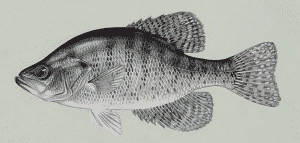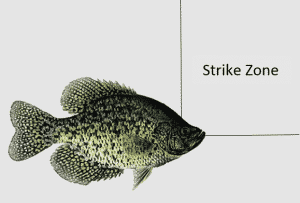Welcome to Crappie 101! Here you will find an overview of the crappie fish, including species, general characteristics, and behavior.
Crappie is one of the most sought after gamefish in the U.S and Canada and for good reason. They are widespread across North America and abundant in many types of bodies of water. Their flaky, delicate meat can be quite delicious on a dinner plate too. They are a member of the Sunfish family, which also includes other popular gamefish like the largemouth bass, bluegill, and pumpkinseed. A few other common names of the crappie include papermouth, Goldring, silver perch, strawberry bass, speck, speckled perch, and calico bass. The length of a common crappie catch is somewhere between 5 and 10 inches. Weight of a 1/2 pound to 3/4 of a pound is typical, although crappie has been caught in the 5-pound range. There are only two species of crappie: the black crappie and the white crappie. Here are the big differences between the two:
Crappie 101: The Black Crappie

- Black crappie is most accurately identified by counting the spines (needle-like bones) on its dorsal fin located on its back. Black crappie usually has 7 or 8. Typically, black crappie is darker than white crappie and have scattered speckles. Their body shape is also slightly rounder.
- Scientific Name – Pomoxis nigromaculatus
- Range – Most common in the northern U.S. and Florida
- Habitat – Cool, clear water with vegetation
- World Record – 6 lb, 0 oz (Caught in Seaplane Canal Westwego in Louisiana in November 1969). There is some debate on the legitimacy of this record. The IGFA lists a slightly smaller black crappie as the world record.
Crappie 101: The White Crappie

- White crappie is most accurately identified by also counting the spines on the dorsal fin. White crappie usually has 5 or 6. Typically, white crappie is lighter than black crappie and have 5-10 vertical bars or bands on their bodies instead of speckles. Their body shape is also slightly more elongated and oval-shaped.
- Scientific Name – Pomoxis annularis
- Range – Most common in the southern U.S with the exception of Florida
- Habitat – More tolerant of murky water and less vegetation
- World Record – 5 lb, 3 oz, (Caught in Enid Dam, Mississippi on 31 July 1957 by Fred Bright)
Aside from black and white crappie, a hybrid between the two exists as well. “Gray” crappie are on the rise as more and more black and white crappie share the same habitat, and there’s always a chance you may catch one.
Some say crappie are not hard fighters but others will beg to differ. Personally, I think it depends on the size of the fish and whether it is on the hunt or biting defensively. In some cases, you may barely feel it when crappie strikes. For this reason, it’s important to keep a sharp watch on your line for any subtle movements. Other times you may mistake an aggressive crappie strike for that of big bass. Either way, they keep you on your toes and are a very fun fish to catch. It is worthwhile to note that when setting the hook to be gentle, as crappie have delicate mouths (the reason for the name papermouth). A steady lift of the tip of the fishing pole is all you need.
When you get on the water and start looking for crappie, it’s important to remember they are considered confined open water fish. What does this mean? Well, there are fish that love to hang out in the weeds, like bluegill and bass, and there are fish that love to hang out in true open water, like chinook salmon. Crappie is somewhere in between. They will spend most of their time cruising the edges of weed beds and other structures, while occasionally venturing out into deeper water. Where they are at exactly depends on the season as well as other variables, but a lot of the time you will find them between structure and open water.
Crappie 101: Diet and Feeding
What crappie eats depends on its size. When they are young, insects, crustaceans,  and zooplankton are common staples of a crappie’s diet. As they get older and bigger though, small fish such as minnows and shad make up most of their diet. Here’s an infographic showing a crappie’s diet. Crappies are sight feeders and will strike almost exclusively upwards. Crappie rarely will go after prey that is below them. If you look at the position of their eyes on their head, this makes sense. You will catch many more crappie if you present your bait/lure right above and in front of them, in their “strike zone”. Crappies are considered nocturnal feeders. They will generally be most active in the early morning, evening, and middle of the night. Therefore, these are the best times to fish for them.
and zooplankton are common staples of a crappie’s diet. As they get older and bigger though, small fish such as minnows and shad make up most of their diet. Here’s an infographic showing a crappie’s diet. Crappies are sight feeders and will strike almost exclusively upwards. Crappie rarely will go after prey that is below them. If you look at the position of their eyes on their head, this makes sense. You will catch many more crappie if you present your bait/lure right above and in front of them, in their “strike zone”. Crappies are considered nocturnal feeders. They will generally be most active in the early morning, evening, and middle of the night. Therefore, these are the best times to fish for them.
Crappie 101: Water Clarity
Although crappies are sight feeders, they will use other senses if they need to at night or when water clarity is low. For this reason, it would be wise to present a lure that appeals to the fish’s sense of smell and/or hearing when fishing murky water. Spinners are a great choice in this situation since they provide vibration as well as shimmer from reflecting light. If crappie is having trouble finding food by sight, the vibration and shimmer provided by a spinner will almost certainly increase your chances of hooking a fish. To appeal to a crappie’s sense of smell, you can tip your hook with a whole or piece of minnow, or by using scented jigs or other additives. Aside from changing up your crappie presentation, you can also fish shallower water in dark or murky conditions. Light won’t penetrate as deeply in these conditions and the crappie may be hanging out shallower than normal. Start by fishing 3-5 feet higher than you normally would and see if you start catching more. The opposite is true too. When water is clear and the sun is bright, crappie will probably be deeper than normal and in denser cover.
Crappie 101 Takeaways:
- There are two crappie species: black and white. A hybrid between the two exists as well, known as the gray crappie.
- Crappie has paper-thin membranes around their mouth, requiring the fisherman to be gentle when setting the hook.
- Crappie is confined open water fish; they spend most of their time on the edge of weed beds, drop-offs, and other structures and occasionally venture out into open water.
- Crappie strikes almost exclusively upwards, so that’s where you should present your lure/bait.
- If water is dark or murky, use brighter colored lures, tip your lure/jig with a piece of minnow, or use a spinner to appeal to the crappie’s other senses.